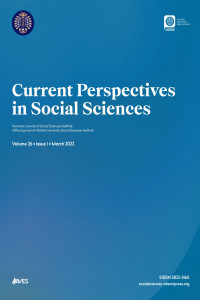McCarthy’s Roots in Tradition and Perception of Nature in The Road
The Road, Cormac McCarthy, ecocriticism, tradition, apocalypse
___
- Bradford, W. (2002). Of Plymouth plantation, 1620–1647. Alfred A. Knopf.
- Bruyn, B. D. (2010). Borrowed time, borrowed world and borrowed eyes: Care, ruin and vision in McCarthy’s. English Studies, 91(7), 776–789. [CrossRef]
- CormacMcCarthy.com. (2014). Complied interviews. The official web site of the Cormac McCarthy society. Retrieved from https://www.cormacmccarth y.com/topic/compiled-interviews/
- Deuteronomy 32:10. Holy Bible. New American Standard Bible.
- Eliot, T. S. (1982). Tradition and individual talent. Perspecta, 19, 36–42. [CrossRef]
- Greenwood, W. P. (2009). Reading Cormac McCarthy. Greenwood Press.
- Hamilton, G., & Jones, B. (2013). Encyclopedia of the environment in American literature. McFarland Company Inc.
- Heller, J. (2015). Does post-apocalyptic literature have a (non-dystopian) future? National Public Radio, Inc. Retrieved from https://www.npr.org/2015/ 05/02/402852849/does-post-apocalyptic-literature-have-a-non-dystopian-future?utm_medium=RSS&utm_campaign=books
- Hicks, H. J. (2016). The post-apocalyptic novel in the twenty-first century: Modernity beyond salvage. Palgrave Macmillan . Kollin, S. (2011). Barren, silent godless: Ecodisaster and Post-abundant Landscape in the Road. In S. Spurgeon (Ed.), Cormac McCarthy all the pretty horses/ no country for old men/ the road (pp. 157–171). Continuum International Publishing Group.
- Başlangıç: 2003
- Yayıncı: Atatürk Üniversitesi
İnci DURSUN, Ebru TÜMER KABADAYI, Elif ARALIK
21’inci Yüzyılda Savaş: Savaşın Dönüşümü ve Yeni Aktörlerin Tipolojisi
McCarthy’s Roots in Tradition and Perception of Nature in The Road
Cinematic Narration in Altın Çocuk and James Bond Differences, Similarities and Geographies
Mert GÜRER, Harun Mustafa TÖLE
The Invisibility of Male Witches in British Culture from the Early Modern Period to Modern Day
Hükümet Sistemleri Üzerinden Mukayeseli Bir Analiz (Parlamenter Sistem–Başkanlık Sistemi)
Muhammet Yasin ELİTOK, Fatih DEĞİRMENCİ
Fârâbî’de Felsefe ve Geometri İlgisi
Seçilmiş Makroekonomik Göstergelerin Çevresel Bozulma Üzerindeki Etkisi: BRICS-T Ülkeleri
